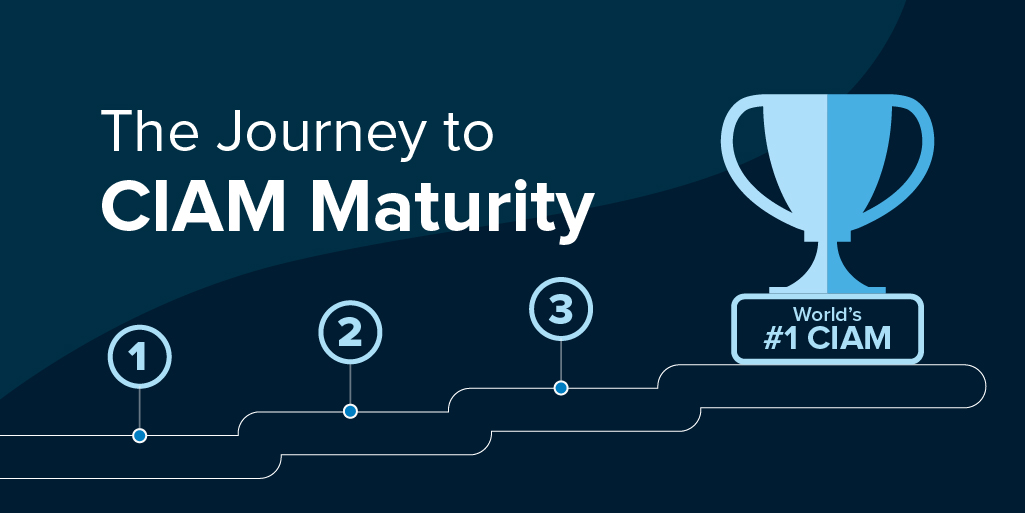The Journey to CIAM Maturity: With Modern Customer Identity, You Can Meet Customers Where They Are
Most businesses are accustomed to supporting internal stakeholders in accessing workforce applications and company data, but what happens when secure access needs to be extended to customers?
Building customer-facing apps that can be brought to market quickly and scaled effectively is a major undertaking. A key component of this is identity and access management (IAM) to keep data safe and provide a seamless experience for customers. When security fails, customer trust falls—and organizations can’t survive without the loyalty and confidence of their consumers.
This is why it’s so critical to understand how your organization measures up in terms of customer and identity management (CIAM) maturity and the steps you can take to continuously improve both security and customer experience. Becoming an advanced CIAM organization is important to your organization’s ability to meet the evolving needs of your future customer base. At Okta, we’ve developed a chart to help companies track where they are in their customer identity journey today and where they should consider advancing next. In this post and the subsequent articles in this series, we will explore each of the stages and how to evolve from one to the other.
To be customer-centric, you need to go digital
The world was already being driven by digital business before COVID-19. Now, as they look beyond 2020, 67% of organizations anticipate substantial increases in online traffic, and 62% of those say it’s largely due to the pandemic. Embracing this increasing traffic is a chance for companies to put their money where their mouth is. Everyone loves to claim that they’re customer-first—but unless they’re serious about customer identity, they won’t be able to back that up.
Letting CIAM fall through the cracks comes with consequences. Building on top of outdated or suboptimal identity and access management during software development can push back release dates by more than six months and lead to major security vulnerabilities. Yet building modern IAM in-house—and building it well—can be a long process. Most organizations would rather focus on delivering refined products and services to their customers than being in the business of identity.
Keeping up with evolving digital needs
In the past, security was concerned with physical, on-prem assets, but the cloud has blown this wide open with new and evolving digital needs. While this allows organizations to deliver better services than they could before, it also complicates the threat landscape.
- Digital experiences are becoming increasingly more complex, with a variety of different applications, new and legacy technology, and more integrations. This means that there are more things to consider when managing data and servers, leading to an increased threat level.
- Consumer expectations are changing. They expect more and digital competitors are increasingly able to deliver on those expectations.
- Consumers are using cloud-based applications more than ever—and bad actors know this and are looking to capitalize on this trend.
Legacy approaches to identity can’t keep up with these challenges, and trying to build identity around these shifts is becoming more complex than ever. Moving away from outdated systems and processes is the only option. By implementing modern identity and access management across customer-facing applications—and securing the underlying APIs and microservices—you can make the most of the speed, scale, and security offered by cloud.
The three components of modern customer identity
This is where modern customer identity comes into the picture. By abstracting identity from an application and putting it into a separate, dedicated CIAM solution, you can streamline access to websites and applications for external stakeholders while fortifying your data and user accounts. A strong CIAM foundation is built on three core features:
- Authentication occurs at the login stage, so you can confirm that the people, devices, and networks accessing your systems are known to you.
- Authorization determines what users can and cannot access once they’ve been properly authenticated.
- User management is the overarching ability for your admins to configure, update, and deploy widespread or granular policies around authentication and authorization.
Introducing the CIAM Maturity Curve
Our CIAM Maturity model was developed to help organizations assess where they are in their customer identity adoption and implementation journeys, and what they need to do next. In a constantly evolving digital landscape, with ever-shifting consumer needs, future-proofing your organization is the only way to succeed—and that’s where CIAM plays an important role.
The maturity curve is broken down into four distinct stages:
- Basic: Describes organizations that are just beginning the process of extending software externally to their customers. In this stage, you may have a small team with limited identity and access management expertise, or a new product that’s still early in its lifecycle.
- Automated: Applies to organizations that have successfully rolled out an application, and now need to build additional products and integrations for customers, all while scaling their offerings. And as customer accounts increase, centralizing user management—and automating lifecycle management—becomes a key priority.
- Intelligent: Implies that organizations are market leaders, and therefore the types and groups of users they interact with are complex and always growing. Protecting data, infrastructure, and users is critical to retaining a competitive advantage, as is delivering great experiences that are friction-free and optimized with analytics.
- Continuous: Is defined by organizations that have digitally transformed themselves with customer identity and security at the center. Seamless, secure, omnichannel experiences that have replaced passwords with efficient yet powerful login factors separate your business from the rest—and by a considerable margin.
In this blog series, we’ll look at each of these stages in detail so that you can chart a course to effective CIAM for your customers and applications—and we’ll show how Okta can help you navigate this voyage. With out-of-the-box solutions that are easy for developers to embed and deploy, Okta accelerates speed to market, lowers the total cost of ownership for your app development, reduces the risk of data breaches, and delivers high scalability and reliability.
Read our CIAM eBook, From Zero to Hero: The Path to CIAM Maturity, for a complete overview of how you can progress across the maturity curve, and check out our whitepaper on why you should invest in a modern customer identity solution rather than build one from scratch.


